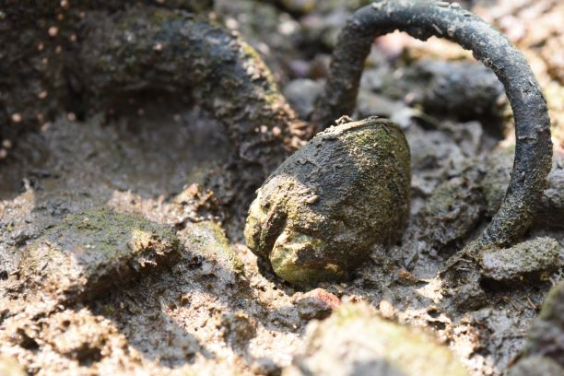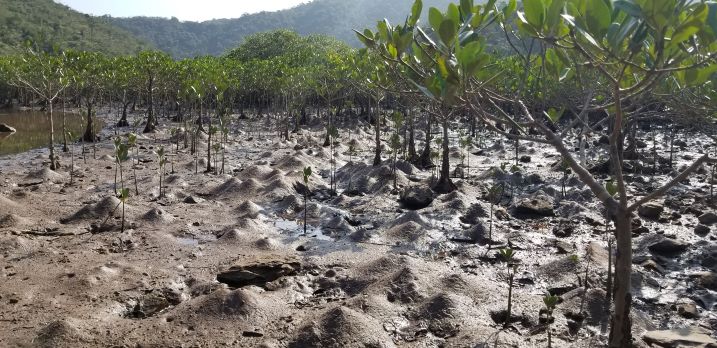Media
Marine ecologists reveal mangroves might be threatened by
low functional diversity of invertebrates
27 Jul 2021

The local mangrove clam Geloina expansa is a filter-feeder but occupies the high-intertidal region of the mangrove forest where tidal inundation is infrequent. This clam has the amazing ability to remain alive for weeks out of water. (Photo credit: Joe S Y Lee)
Mangrove forests worldwide host invertebrate assemblages with low functional diversity. (Photo credit: Stefano Cannicci)

Invertebrate animals influence many ecological functions of mangrove forests, like the change in surface topography caused by the mounds of burrowing crustaceans at Sam A Chung, located in the northeastern part of Hong Kong. (Photo credit: Joe S Y Lee)
A large number of crabs, such as this Metopograpsus frontalis, find food and shelter in mangrove forests. (Photo credit: Stefano Cannicci)
Large crabs, such as Chiromantes haematocheir, constantly rework the sediment, providing nutrients and oxygen to the mangrove trees. (Photo credit: Stefano Cannicci)
- 1 / 5
- 2 / 5
- 3 / 5
- 4 / 5
- 5 / 5
Mangrove forests were once dominant in the tropics but have recently been disappearing at alarming rates worldwide. Although this threatened ecosystem supports a broad range of specialised invertebrates, little is known about the impact of mangrove deforestation on the functional diversity and resilience of these resident fauna.
The International Day for the Conservation of the Mangrove Ecosystem (also known as the World Mangrove Day), declared by UNESCO and celebrated every year on 26th July, aims to raise awareness on the importance of mangrove ecosystems. Mangroves are more than just trees, together they form a unique, special and vulnerable habitat. Their ecological functioning depends upon the mutual relationships between their floral and faunal components, and there is no viable mangrove forest without a healthy community of invertebrates sustaining it.
To address this question, which is crucial in order to manage pristine mangroves and rehabilitate degraded ones, Dr Stefano CANNICCI (Associate Director of the Swire Institute of Marine Science and Associate Professor from the Research Division for Ecology & Biodiversity, The University of Hong Kong), along with Professor Joe Shing Yip LEE (Professor and Director, Simon FS Li Marine Science Laboratory, School of Life Sciences, The Chinese University of Hong Kong) and their colleagues compiled a dataset of 209 crustacean and 155 mollusc species from 16 mangrove forests around the world. They found that mangroves, when compared with other ecosystems, are among those with the lowest functional redundancy among resident fauna recorded to date, which suggests that these coastal vegetations are one of the most precarious ecosystems in the world in the face of the recent anthropogenic changes. Thus, a high functional redundancy is a sort of ‘ecological insurance’ for a given forest, since if one species is lost, another can fulfil its function, ultimately keeping the ecosystem viable.
Diversity: The key to survival
The authors classified these species into 64 functional entities based on unique combinations of three functional traits: feeding habits, behavioural traits potentially affecting ecosystem characteristics, and micro-habitat. More than 60% of the locations showed no functional redundancy, i.e., most of the functional entities at those locations consisted of only one species, with the notable exceptions being locations in South America, the eastern Indian Ocean and the western Pacific Ocean. On average, 57% of the functional entities are performed by a single species, suggesting that even a modest local loss of invertebrate diversity could have significant negative consequences for mangrove functionality and resilience, because invertebrates are crucial for the mangrove nutrient cycling and for oxygen provision to the tree roots and these functions will be lost with a decrease in functional diversity.
Moreover, the low functional diversity of the resident invertebrates indicates that mangroves are among the most vulnerable ecosystems on the planet. Nonetheless, some small mangrove patches, such as those in Hong Kong and Mozambique, harbor multifunctional invertebrate assemblages that may serve as biodiversity reservoirs, which could prove critical for future conservation efforts. Mangrove trees can be replanted but the local invertebrate fauna needs to naturally recruit the newly replanted sites. Without faunal recruitment, mangrove will not be able to develop, due to the lack of nutrients and oxygen in the soil. By contrast, some large forests, such as those in Cameroon, were characterised by low invertebrate functional diversity. Taken together, the findings suggest that faunal functional diversity may be a better measure of mangrove resilience than the conventional indicator of forest size. One of the most important messages to take away from this study is that, although the mangroves in Hong Kong are very small, they are very diverse, and they are still home for a lot of species, which perform multiple functions in the environment. Therefore, the mangroves in Hong Kong are the last pristine, and natural mangroves in the Pearl River Delta, and they could be sources of populations that can re-populate mangroves even in mainland China.
According to the authors, studying the functional diversity of the resident faunal assemblages is crucial for assessing the vulnerability of mangrove forests to environmental change and for designing effective management, conservation, and restoration plans. At present, the health and resilience of mangrove forests around the world are assessed through their overall increase in area. This approach, however, does not consider the real viability and functionality of those forests. A mangrove forest is not just a group of trees, but a complex ecosystem also built upon healthy faunal communities and on the interaction between such communities and the trees. Mangrove management and rehabilitation projects need to take into account not just the increase in size of a mangrove, but also the stability and redundancy of its faunal component.
The findings were recently published in The Proceedings of the National Academy of Sciences (PNAS), the official journal of the National Academy of Sciences (NAS).
The journal paper can be accessed from here: https://doi.org/10.1073/pnas.2016913118
For media enquiries, please contact Ms Casey To, External Relations Officer (Tel: 3917-4948; email: caseyto@hku.hk ) and Ms Cindy Chan, Assistant Communications Director of Faculty of Science (Tel: 3917-5286; email: cindycst@hku.hk ) from HKU, or Mr Henry Kwan, Public Relations Executive, Communications and Public Relations Office (Tel: 3943-1719; email: henrykwan@cuhk.edu.hk) from CUHK.
Images download and captions: https://www.scifac.hku.hk/press
